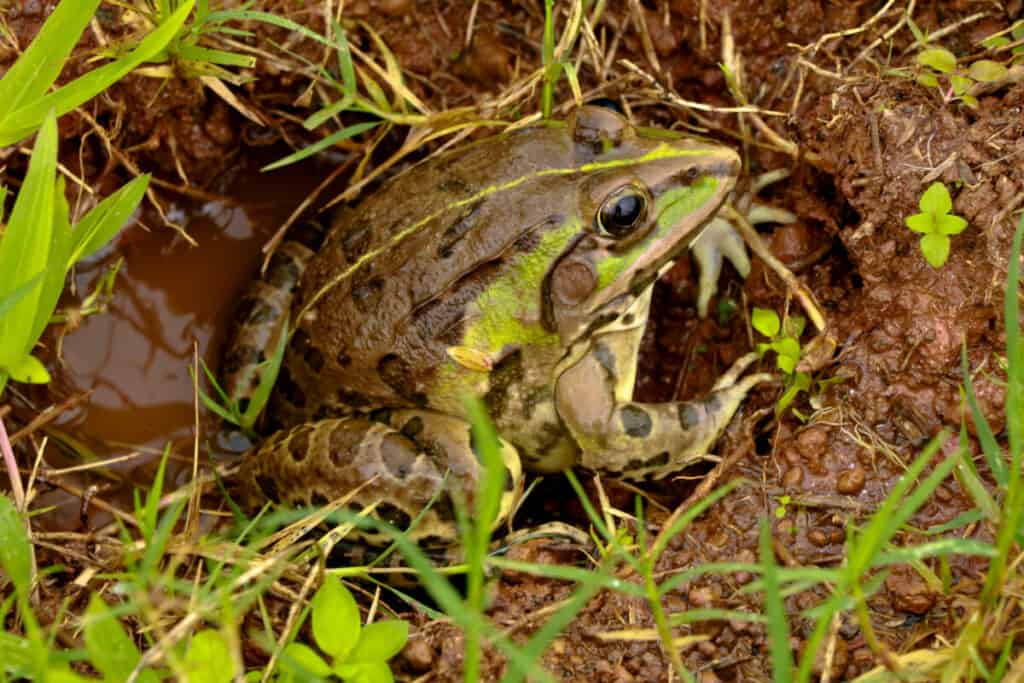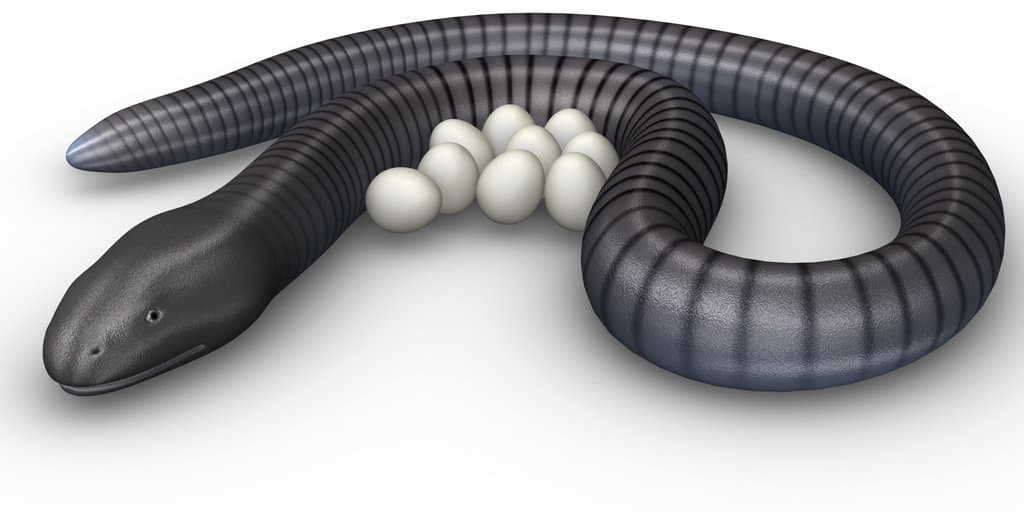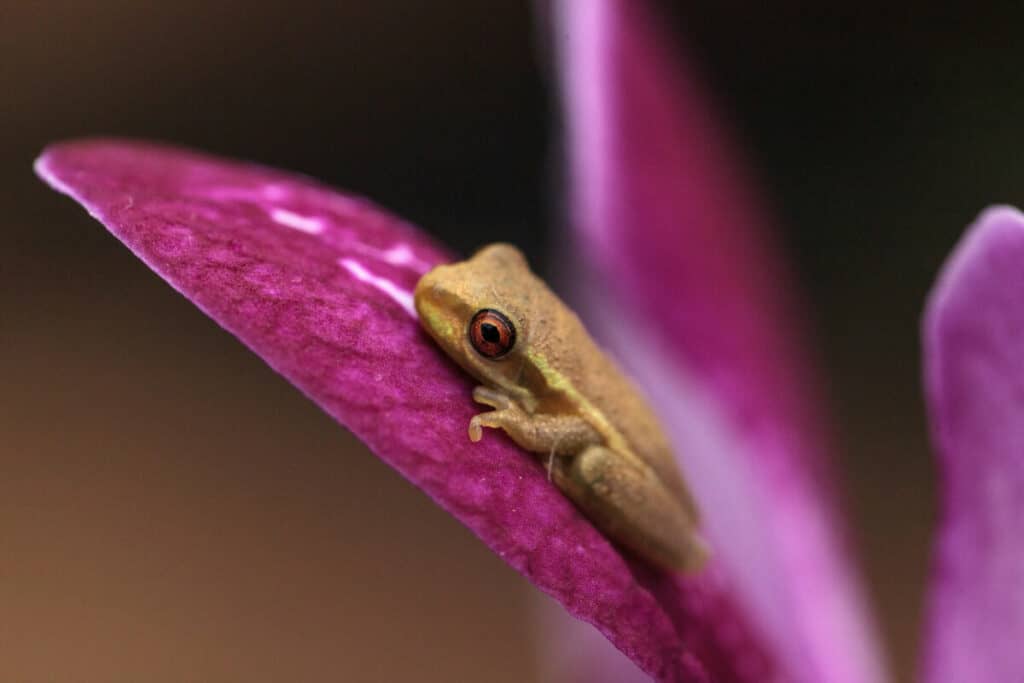
Creepy, crawly, slimy. When you think of amphibians like frogs and salamanders you can’t help but think of their close friends: reptiles like snakes and lizards. Due to their similarities, you might wonder if amphibians have scales as well?
Most amphibians do not have scales. Common amphibians, like frogs, are defined by having soft moist skin instead of hard scales. However, there is one type of amphibian that does have scales: Caecilians. Caecilians still have soft skin like most amphibians but also have rings of scales.
Caecilians are not very common, but they are incredibly interesting. Read on to learn more about amphibians, their skin, and why they typically don’t have scales.
Amphibians without Scales
The easy answer to the question of whether amphibians have scales is no, they don’t. While there is one specific type of amphibian that does, the vast majority of amphibians do not. Amphibiaweb, a website that collects data and numbers about amphibians, lists three different types of amphibians.
These three types are Anura (frogs), Caudata (salamanders), and Gymnophiona (caecilians). Frogs and their related species make up almost 90 percent of all amphibians (88%). Salamanders make up another 9%, leaving our exceptional caecilians only making up 3% of all amphibians.
Amphibians tend to have softer skin due to the way they live compared to other animals. Amphibians go through a metamorphic process as they grow. This process of metamorphosis allows them to change their bodies drastically as they grow.
A simple example is a process that frogs go through. Frogs are born from eggs laid in water. When they are born, they start out as small tadpoles with gills. As they grow, they get larger and begin to develop legs.
Using these legs, they can begin to venture onto land for short trips. As these trips become longer, they rely less on their gills and develop lungs that can breathe air. Once they are fully grown, they have legs, their tails have shrunk away, and they breathe air.
Amphibian’s Skin Can Help Them Breath
Many amphibians aren’t able to survive just on the air provided by their lungs and need to supplement it somehow. This is where their skin comes in.
Most amphibians are able to use their soft, moist skin to help them breathe. As well as through their lungs, they are able to collect oxygen through their skin. In order to do this, their skin needs to be kept moist.
As long it is kept moist with clean water, the amphibian is able to thrive. This is one of the reasons that most amphibians are found close to fresh water. It is also one of the reasons that amphibians are so vulnerable to changes in their environment.
With their dependence on clean water, amphibians can quickly become vulnerable if there are any changes to their access to water. Changes are often caused by expansion by humans into the area. If the local amphibians’ access to the area is blocked by roads or construction, they will find it difficult to keep their skin moist. If the water is contaminated, then it can cause damage to their skin or any eggs that are incubating in the water.
Amphibians with Scales
On the other hand, there are a select few amphibians that do have scales. These amphibians, all members of the Gymnophiona group, are known commonly as Caecilians. Like the picture below, their appearance is similar to that of a snake or giant worm. The smallest of them can be only a couple of inches long, and the largest of them can grow to five feet. Many of them burrow and live underground. This may be one reason for their unusual shape.

Like other amphibians, Caecilians have supple, moist skin. They lay their eggs in wet soil or water and develop in several stages through metamorphosis. Unlike other amphibians, on top of their soft skin, they also have scales. In research done by scientists recorded in the Saudi Journal of Biological Sciences, they describe the scales found on Caecilians. Scattered throughout the Caecilian’s skin are small pockets of scales. These scales form rings around glands buried in their skin, and there are around 1-4 scales found in each pocket.
These glands in their skin secrete mucus that helps to keep their skin moist. This mucus is potent, with one researcher describing the experience of catching a Caecilian as, “like trying to get a good grip on a bar of soap.” Not only does this mucus help keep their skin moist, but it also may help them as they burrow into the ground. By keeping their body slippery, they would be able to maneuver their body through the soil and tunnels. Their scales may also play a role here by giving them a tool to brace and anchor themselves on the tunnel walls.
Differences between Amphibians and Reptiles
While they might seem similar on the surface, there are many differences between amphibians and reptiles. These differences aren’t limited to whether they have scales or not, though that is an easy way to differentiate most of them. There are significant differences that lead scientists to separate them into different groups.
One of the biggest differences between amphibians and reptiles is how they develop and grow. While amphibians will develop through metamorphosis, reptiles don’t use this process. Instead of being born as a larva and developing in stages, reptiles are born as miniature versions of their adult selves. While they may develop new traits as they grow in size, they won’t change their form, for example from a leg-less tadpole to a tail-less frog.

Another difference between them is the areas that they are able to live in. While amphibians need to be in tropical climates or near water to keep their skin moist, reptiles don’t require an area with an abundance of water.
Due to this, reptiles are able to live in more diverse and dryer climates than most amphibians. While they have a wider range, reptiles are still cold-blooded animals and can’t live in climates that are cold year-round.
